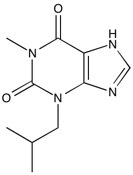IBMX | PDE inhibitor
NMR (Conforms)

Available Options
| Size : | Price | Quantity | |
|---|---|---|---|
| 100 mg | $36.00 | ||
| 1 Gram | $155.00 |
IBMX (28822-58-4) is a pan-specific inhibitor of phosphodiesterases (IC50=2-50 µM). Inhibition of PDEs leads to increased concentration of intracellular cAMP which activates PKA.2 IBMX does not inhibit PDE8 or PDE9.3 Weak adenosine receptor antagonist.4
References/Citations:
1) Beavo et al. (1970), Effects of xanthine derivatives on lipolysis and on adenosine 3′,5′-monophosphate phosphodiesterase activity; Mol. Pharmacol., 6 597
2) Tomes et al. (1993), Isobutylmethylxanthine and other classical cyclic nucleotide phosphodiesterase inhibitors affect cAMP-dependent protein kinase activity; Cell Signal., 5 615
3) Soderling et al. (2000), Regulation of cAMP and cGMP signaling: new phosphodiesterases and new functions; Curr. Opin. Cell Biol., 12 174
4) Daly et al. (1987), Adenosine receptors: development of selective agonists and antagonists; Prog. Clin. Biol. Res., 230 41
NMR (Conforms)
Safety Data Sheet:
Product Data Sheet:
Materials provided by Focus Biomolecules are for laboratory research use only and are not intended for human or veterinary applications. Please note that we do not sell to individuals and that all orders placed by non-research organizations will incur a $20 restocking/refund fee
IBMX (28822-58-4) is a pan-specific inhibitor of phosphodiesterases (IC50=2-50 µM). Inhibition of PDEs leads to increased concentration of intracellular cAMP which activates PKA.2 IBMX does not inhibit PDE8 or PDE9.3 Weak adenosine receptor antagonist.4
References/Citations:
1) Beavo et al. (1970), Effects of xanthine derivatives on lipolysis and on adenosine 3′,5′-monophosphate phosphodiesterase activity; Mol. Pharmacol., 6 597
2) Tomes et al. (1993), Isobutylmethylxanthine and other classical cyclic nucleotide phosphodiesterase inhibitors affect cAMP-dependent protein kinase activity; Cell Signal., 5 615
3) Soderling et al. (2000), Regulation of cAMP and cGMP signaling: new phosphodiesterases and new functions; Curr. Opin. Cell Biol., 12 174
4) Daly et al. (1987), Adenosine receptors: development of selective agonists and antagonists; Prog. Clin. Biol. Res., 230 41
Calculate the molar concentration, mass or volume in a solution.
Concentration × Volume × Molecular Weight = Mass
Focus Biomolecules • Plymouth Meeting, PA USA • 1-855-FOCUS21
Focus Biomolecules
Plymouth Meeting, PA USA
1-855-FOCUS21
Website Created by Advanta Advertising LLC.

